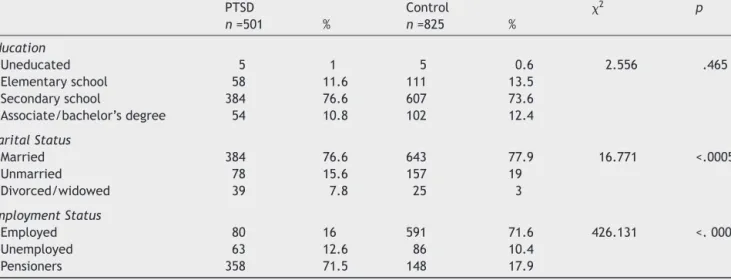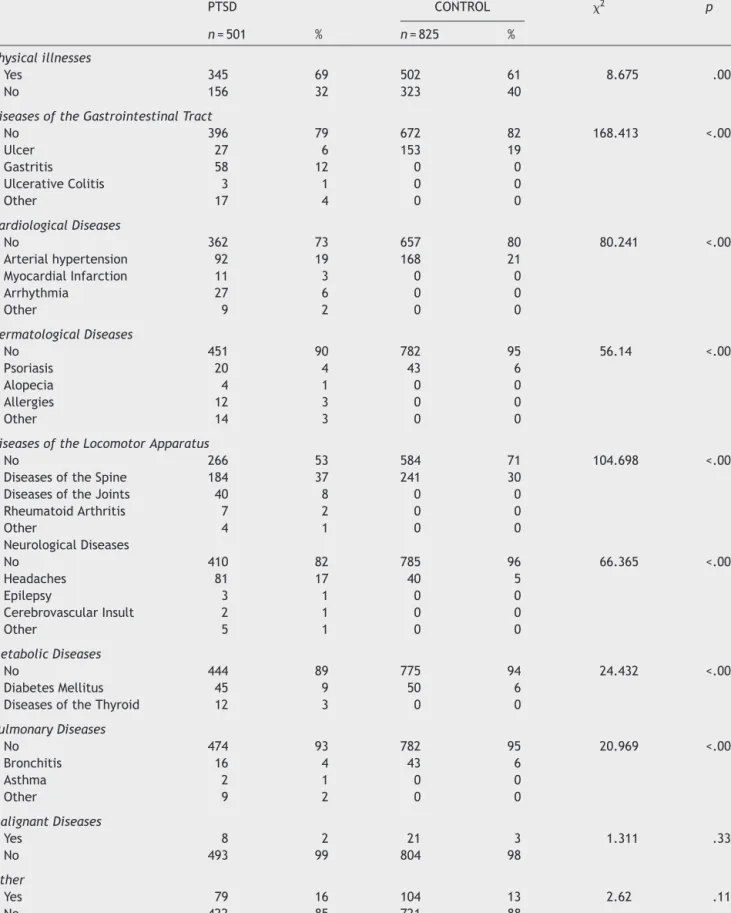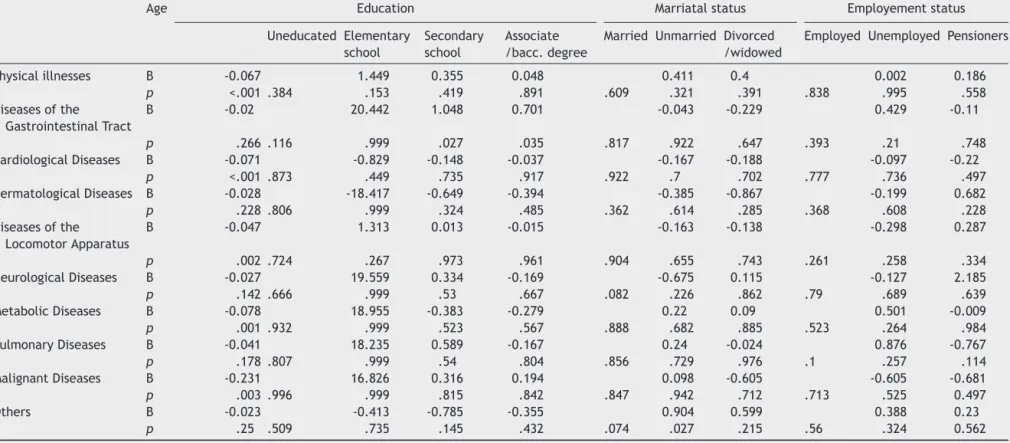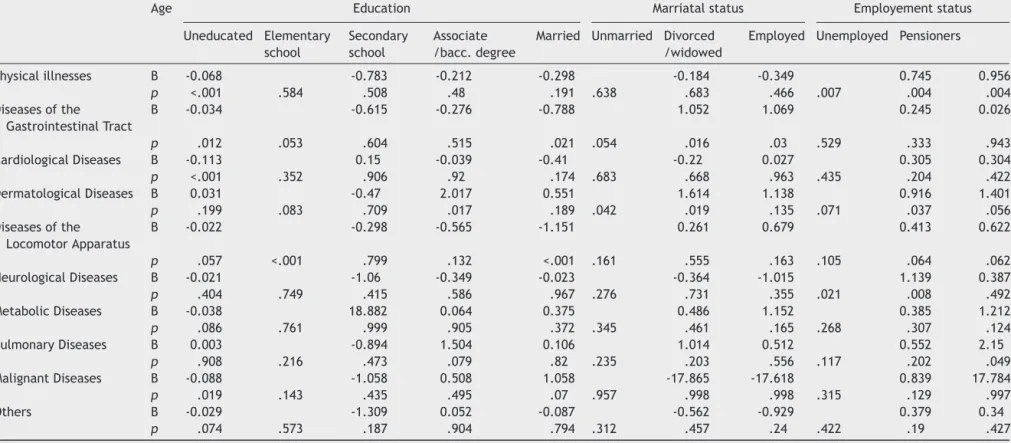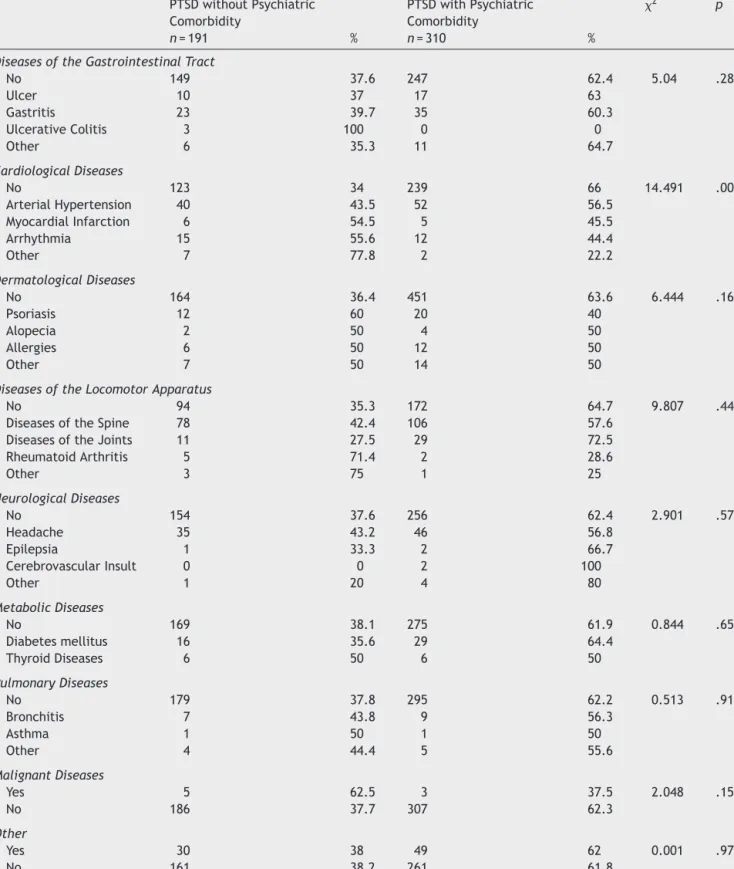www.elsevier.es/ijchp
International
Journal
of
Clinical
and
Health
Psychology
ORIGINAL
ARTICLE
Comorbidities
with
Posttraumatic
Stress
Disorder
(PTSD)
among
combat
veterans:
15
years
postwar
analysis
Dolores
Britvi´
c
a,
Vesna
Antiˇ
cevi´
c
a,
Mariano
Kaliterna
a,∗,
Linda
Luˇ
si´
c
a,
An –
delko
Beg
a,
Igna
Brajevi´
c-Gizdi´
c
a,
Mirjana
Kudri´
c
b, ˇ
Zeljana
Stupalo
b,
Vikica
Krolo
b,
Nela
Pivac
c aUniversityofSplitHospitalandSchoolofMedicine,CroatiabPrivateFamilyPractice,Croatia cRudjerBoskovicInstitute,Croatia
Received7August2014;accepted18November2014 Availableonline25December2014
KEYWORDS PTSD; Combat; Veterans; Surveydescriptive study
Abstract Theaimofthisstudywastoinvestigatethedifferencesintheprevalenceofsomatic diseasesamongcombatveteransandtheircontemporarieswhowerenotexposedtothe trau-matic experience at thebattlefield, andto determine whether socio-demographicfactors, exposure to war-time traumaand/or injury might predict individualsomatic diseases. The studyincluded1,558subjectslivinginsouthCroatia:501malecombatveteranswith Posttrau-maticStress Disorder(PTSD)andthecorrespondingcontrolgroupof825menwhowere not exposed tocombat experience.Veterans withPTSD,regardless ofthe lengthoftimespent inwar,sufferedmoreoftenfromcardiovascular,dermatological,musculoskeletal,pulmonary andmetabolicdiseasesthancorrespondingcontrolsubjectswhowerenotexposedtocombat experience.Thepredictorsofcardiovascular,musculoskeletalandmalignantdiseasesin vet-eranswereage,lengthoftimespentincombat,havingbeenwounded.Alongerperiodinthe combat zonewasassociatedwitharrhythmiasinveteranswithPTSDcomplicatedwithother psychiatriccomorbidities.PTSDasaresultofexposuretowartraumaincreasesthepossibility ofdevelopingsomaticdiseases.
©2014AsociaciónEspa˜noladePsicologíaConductual.PublishedbyElsevierEspaña,S.L.U.This isanopenaccessarticleundertheCCBY-NC-NDlicense(http://creativecommons.org/licenses/ by-nc-nd/4.0/).
∗Correspondingauthorat:UniversityHospitalSplit, ˇSoltanska1,21000Split,Croatia.
E-mailaddress:mariano.kaliterna@gmail.com(M.Kaliterna).
http://dx.doi.org/10.1016/j.ijchp.2014.11.002
1697-2600/©2014AsociaciónEspa˜noladePsicologíaConductual.PublishedbyElsevierEspaña,S.L.U.Thisisanopenaccessarticleunder theCCBY-NC-NDlicense(http://creativecommons.org/licenses/by-nc-nd/4.0/).
82 D.Britvi´cetal. PALABRASCLAVE TEPT; Combate; Veteranos; Estudiodescriptivo medianteencuestas
ComorbilidadesconelTrastornodeEstrésPostraumático(TEPT)entreveteranosde guerra:unanálisisalos15a˜nosdespuésdelaguerra
Resumen Elpropósitodeesteestudiohasidocompararlafrecuenciadetrastornos somáti-cosenveteranosdeguerray personasnoexpuestasala experienciatraumática delcampo debatalla,asícomodeterminarsilaexposiciónafactoressocio-demográficos entiempode guerrapuedenpredisponeratraumas,alteracionesotrastornossomáticos.Elestudioincluye 1,558 sujetosdel sur deCroacia: 501 varonesveteranos deguerra consíndrome de estrés postraumático(TEPT) y un grupo decontrol de825 varones noexpuestos a la experiencia decombate. LosveteranosconTEPT, independientemente deltiempopasado enla guerra, desarrollanmásamenudoalteracionesgastrointestinales,cardiovasculares,dermatológicas, locomotoras,pulmonaresymetabólicasquelossujetosdelgrupocontrol.Losindicadoresde alteracionescardiológicas,locomotoras,entreotros,enveteranoshansidolaedad,eltiempo pasado encombate y elda˜no allísufrido.Un largoperíodoenla zona de combatehasido asociadoconarritmiasyotrascomplicacionesdetipopsiquiátrico.ElTEPT,comoresultadode laexposiciónaexperiencias traumáticasdelcampo debatalla,incrementala posibilidadde desarrollodetrastornossomáticos.
©2014AsociaciónEspa˜noladePsicologíaConductual.PublicadoporElsevierEspaña,S.L.U.Este esunartículoOpenAccessbajolalicenciaCCBY-NC-ND(http://creativecommons.org/licenses/ by-nc-nd/4.0/).
Numerousstudieswithdivergentresultshaveexamined theconnectionbetweenphysicalandmentalhealth,andthe impactofstressandtraumaticeventsonthe hypothalamic-pituitary-adrenal(HPA)axis,withtheconsequentmetabolic disordersandimpairmentsofcortisolsecretionandlipid sta-tus(Ginzburg&Solomon,2011),orphysicalhealthincombat veteranswithPTSD(O’Toole&Catts,2008;Vasterlingetal., 2008).These contradictoryresults supportthecomplexity ofthisrelationship,inadditiontotheimportantinfluences of genetic vulnerability, the HPA axis changes, smoking andsubstanceabuse(Qureshi,Pyne,Magruder,Schultz, & Kunik,2009; Zen, Whooley, Zhao, & Cohen, 2012). Some studiesreportedahigherincidenceofarthritis,pulmonary disease(O’Toole & Catts, 2008),dermatological disorders (eczema),backand other musculoskeletal disorders, gen-itourinary disorders in the general population with PTSD (Glaesmer,Brähler,Gündel,&Riedel-Heller,2011)and vet-erans (O’Toole & Catts, 2008), while others showed a significant association between PTSD and diabetes (Boyko etal.,2010), psoriasis,thyroid disease(Boscarino,2004), cardiovascular diseases (Coughlin, 2011; Edmundson & Cohen,2013)andulcers(Fink,2011).Thefactthatover50% ofveteranswithPTSDalsohaveanotherpsychiatric diagno-sis(Ginzburg,Ein-Dor,&Solomon,2010)raisesthequestion oftheimpactofpsychiatriccomorbidityontheoccurrence ofphysicalillnesses.Wearenotawareofanyprevious stud-iesinvestigatingthedifferencesintheprevalenceofsomatic disordersamongveteranswithPTSD,withorwithout comor-bid diagnoses. Given the large numbers of veterans with PTSDinCroatiaintheaftermathofthe1991-1995war,who undoubtedlyrepresentasignificantpublichealthproblem, thereisaneedtostudytheirphysicalhealth.
Theaimofthisstudywastoinvestigatethedifferences intheprevalenceofsomaticdiseasesamongcombat veter-ansandtheircontemporarieswhowerenotexposedtothe traumaticexperienceinthe battlefield,andtodetermine whether socio-demographic factors (education, marital
status,employmentstatus),theeffectsofcombatexposure towartimetrauma,and/orinjurymightbeusedas predic-tors of development of somatic diseases. The hypothesis wasthat veterans willhave higher prevalence of somatic disorders compared to the general population matched for age and sex, and that those injuries and traumatic experiences will significantly influence the occurrence of somaticillnessesinveterans.Anotheraimwastoelucidate a prevalence of somatic diseases among veterans with PTSD andpsychiatriccomorbidities,comparedtosubjects withoutcomorbiddiagnoses.
Method
Participantsandinstruments
This case control study included 1,558 subjects living in central Dalmatia in the region of Split-Dalmatia County. The test group consists of male combat veterans, 36 to 65 years of age, diagnosed with PTSD resulting from the combatexperienceaftertheHomelandwarinCroatia,who wereinoutpatienttreatment.The groupwasformedfrom asampleofallcombatveteranswhowerediagnosedand/or treatedattheRegionalCenterforPsychotrauma,Split Clin-icalHospitalCenter,fromMay2010toMay2011.Atotalof 1,023veteranswereexamined,ofwhom759werediagnosed withPTSDand501 agreedtoparticipateinthestudy.The remaining258wereexcludedfromthestudyduetovarious reasons;108ofthemdidnotacceptedtoparticipateinthe study,withtheother150questionnaireswerenotproperly filled,(49ofthemMississippiscalewasnotproperlyfilled, andin101thedatawereinsufficient).ThediagnosisofPTSD wasestablishedaccordingtothediagnosticcriteriaforPTSD based on the ICD-10 criteria (World Health Organization, 1992),but alsowitha StructuredClinicalInterview(SCID) for DSM-IV (First, Spitzer, Gibbon, & Williams, 2000). All
participantswereassessedsystematically.Particular symp-toms were evaluated using the self-report questionnaire of the MississippiScale for Combat Related Posttraumatic Stress Disorder (M-PTSD) (Keane, Cadell,& Taylor, 1988). PTSDassessedbasedoncombat/militarytraumasonly.This questionnaireisa35-itemself-reportmeasurethatassesses combat-related PTSD in veteran populations. This mea-sure hasdemonstratedgoodtest-retest reliability(r=.97, 1-weekinterval),internalconsistency(alpha=.94)and diag-nosticaccuracy (90% diagnostic efficiency) in asample of Vietnam combat veterans (Kulka et al., 1991). Selected symptomswerecollectedanddiagnosesestablishedbythree psychiatristsandtwopsychologistswithanextensive expe-rienceinwarrelatedpsychopathologieswhowereworking withveteranswithPTSD.Comorbiddiagnoseswere estab-lishedusingtheICD-10andSCIDaccordingtoDSM-IV.
The average age of the participants was 47.5±6.6 years. Most of them (n=384) had a secondary school education (10---12 years of school). The majority (n=384) were married, 78 weresingle, 37 were divorcedand two werewidowed.Thelargestnumber(n=358)wereretired, while 63of themwereunemployed and80 veteranswere employed.Mostoftheparticipants(n=202)hadspentmore than threeyearsonthe battlefield,104 between 2and 3 yearsand130between1and2years.Ofthetotalnumber, 47hadbeenwounded.
Control group. The total patient populations of three familymedicalpracticesinthreedifferentcitieswere exam-ined,whichincluded personsfromurban,ruralandisland milieus, which werenot exposed towar activities. There werea total of5,000 subjects, ofwhom 2,389were men and825metthecriteriaforparticipationinthestudy.The inclusioncriteriaweremalegenderbetween36and65years ofage.Theexclusioncriteriaweretheexistenceof psycho-logical problems or psychiatric treatment (all codes from F-01toF-09,according totheICD-10)andcombatdutyin theHomeland war. Fromallpatient population,913 were youngerthan35orolderthan65years,561subjectswere involved in acts ofwar. From thesubjects examined,204 showed psychological problems, of which 114 as a result ofparticipationinthewar.Assessmentofphysicaldiseases wasconducted by systematic examination of the medical records,medicalexaminationbythreeexperiencedfamily physicians who receivedequivalent training, but unfortu-nately without rater-interrater reliability. Assessment of psychiatricdisordersinthecontrolgroupwasconductedby afamilyphysician,whofoundnocriterionforthediagnosis ofdisordersoftheF00-F99ICD-10.Inaddition,inspection in the whole lifemedical recordsfor each of the control respondentsdidnotrevealpresenceofanypsychiatric disor-ders.Averageageofthecontrolgroupwas46.9±7.9years. Out of 825included control subjects,most of the partic-ipants (n=607) had a secondary school education (10---12 yearsofschool).Themajority(n=643)weremarried,157 weresingleand25weredivorcedorwidowed.Thelargest numberwereemployed(n=591),148wereretiredwith pen-sionsand86wereunemployed.
Procedureanddataanalysis
Data were collected by three psychiatrists, two psychol-ogists and four family physicians using a questionnaire
especiallydesignedforthispurpose.Thequestionnaire col-lected data on socio-demographic status (marital status, education, employment status, presence/absence at war and for the group of veterans the length combat duty and wounds). The data on physical illness were divided intogastrointestinal, cardiovascular, dermatological, neu-rological,metabolic,pulmonary, musculoskeletalsystems, tumors,andotherdiseasegroups. Informationondiseases wasobtained from interviews withthe subjects, medical examinationandinspectionoftheirmedicalrecords.
Theresultingdatadescribedthesociodemographicdata, dataonthediseasesinbothgroups(veteransandthe gen-eralpopulation)anddifferencesindiseases, thelengthof combat duty during the war and wounds incurred, which represented predictors of individual physical illnesses. In the second analysis, the frequencies of physical illnesses inveteranswithandwithoutpsychiatriccomorbiditywere compared.
Univariatelogisticregressionwasperformedinorderto determine the oddsratio for a specific diagnosis in cases andcontrols.Forthispurpose,allthevariablesofaspecific diagnose(includingDiseases of theGastrointestinal Tract, CardiologicalDiseases,DermatologicalDiseases,Diseasesof theLocomotorApparatus,NeurologicalDiseases,Metabolic Diseases,PulmonaryDiseases,MalignantDiseasesandOther) wererecodedintovariableswithtwolevels(YES= is diag-nosedwiththespecificdisease;NO=isnotdiagnosedwith thespecificdisease).Allthebinarylogisticregression anal-ysiswereperformedwiththeinclusionofrecodedvariables in the model. The adjusted odds ratios were calculated aftertheinclusionofthefollowingpossibleconfounding fac-torsin themultiple binarylogistic regressionmodel: age, education, marital status and employment status. Along with the adjusted odds ratios for a specific disease, Chi squaresandapvalueofaspecificmodelincludingthe possi-bleconfoundingfactorswerereported.Thevariableswere evaluateddescriptively (presentedasmeans andstandard deviation), and analyzed using binary logistic regression. Forasubsequentcomparisonbetweenthegroups,the Stu-dent’st-testand2testwereused.Thesoftwareprogram SPSS12.0 for Windows(Chicago, IL: SPSS Inc., 2003) was used for data analysis, with the significance level set at .05.
ThestudywasapprovedbytheEthicsCommitteeofthe University of Split Hospital Center. All the subjects were familiarizedwiththestudyandgavetheirwritteninformed consent.
Results
Differencesinthesociodemographicfactors
Therewasnosignificant differencein ageofthe veterans andcontrol group (t=1.36 p= .174). However, significant differencewas detected in marital status (2 (2)=16.77; p=.0005)andemploymentstatus(2(2)=426.13;p=.0005). Inthecontrolgroup,therewasamarginallyhighernumber ofunmarriedmenandalowernumberofdivorcedmenand widowers.Regardingemploymentstatus,theveteranswere morefrequentlyretiredand subjectsinthe controlgroup weremorefrequentlyemployed(Table1).
84 D.Britvi´cetal. Table1 DifferencesinthesociodemographicfactorsbetweenveteranswithPTSDandthecontrolgroup.
PTSD Control 2 p n=501 % n=825 % Education Uneducated 5 1 5 0.6 2.556 .465 Elementaryschool 58 11.6 111 13.5 Secondaryschool 384 76.6 607 73.6 Associate/bachelor’sdegree 54 10.8 102 12.4 MaritalStatus Married 384 76.6 643 77.9 16.771 <.0005 Unmarried 78 15.6 157 19 Divorced/widowed 39 7.8 25 3 EmploymentStatus Employed 80 16 591 71.6 426.131 <.0005 Unemployed 63 12.6 86 10.4 Pensioners 358 71.5 148 17.9
Differencesinphysicalmorbiditiesbetweenthe
veteranswithPTSDandcontrolgroup
Thedifferenceintheoverallprevalenceofphysicalillnesses between these two groups was significant (2 (1)=8.67; p=.003) in the morbidity from gastrointestinal, cardiac, dermatological,musculoskeletal,respiratoryandmetabolic diseases (Table 2). With the exception of gastrointestinal illnesses, all other somatic diseases were more prevalent amongthecombatveteranssufferingfromPTSDcompared tocontrolgroup.Inthegroupofsubjectswith gastrointesti-nalillnesses,ulcerdiseasewasmorecommoninthegeneral population,whilegastritisandulcerativecolitisweremore prevalentamongthecombatveterans(Table 2).Although totalcardiovasculardiseasesweresignificantlymore com-monamongthecombatveterans,arterialhypertensionwas morecommoninthecontrolgroup,whilemyocardial infarc-tion, arrhythmia and other illnesses were more common in the group of combat veterans. Out of dermatological diseases, psoriasis wasmore common in the control pop-ulation, but allergies, alopecia and other diseases were more frequent in the group of veterans (2 (4)=51.14; p= .001).Alldiseases ofthe musculoskeletal systemwere morefrequentincombatveterans(2(4)=104.69;p<.001), which include spinal disorders, arthritis and rheumatoid arthritis,comparedtocontrolsubjects.Allneurological dis-easesweremorecommoninthegroupofcombatveterans (2 (4)=66.36; p= .001), with the most common consist-ing of headache, epilepsy and cerebrovascular insult(s). Metabolic diseases were more common in combat veter-ans (2 (2)=24.432; p< .001), such as diabetes mellitus andthyroiddisease, thanin controlsubjects. Therewere nodifferences in the frequencies of malignant and other diseasesbetweenthesetwogroups(Table2).Allstated dif-ferencesarestatisticallysignificantalsowhentheinfluence onlengthoftimespentincombatiscontrolled,anditmeans thatdifferencesinmoreoftenphysicalillnessesinveterans aremainlyresults ofPTSDratherthandurationoftrauma exposure(Table3).
The results of the binarylogistic regression confirmed thatthepatientswithPTSDwerestatisticallysignificantly
morelikelytobediagnosedwithcardiological, dermatolog-ical, neurological, metabolic diseases and diseases of the locomotorapparatus(Table4).Whenadjusted forpossible confoundingfactorsamongthecasesandcontrols,including age,education,maritalstatusandemploymentstatus,the adjustedoddsratioswerestillstatisticallysignificantinall variablesthatprovedsignificantintheunivariateregression model. After the adjustment, PTSD patients were almost 4timesmorelikelytobediagnosed withneurological dis-eases (odds ratio 3.856; 2.381-6.246; p< .001), and two timesmorelikelytobediagnosedwithdiseasesofthe loco-motor apparatus (odds ratio 2.141; 1.602-2.862; p<.001) anddermatologicaldiseases(oddsratio2.021;1.185-3.445; p=.010).Oddsratioformetabolic(oddsratio1.779; 1.089-2.907;p=.021)andcardiologicaldiseases(oddsratio1.423; 1.016-1.993;p=.040)weresomewhatsmaller,butstill sta-tisticallysignificantaftertheadjustment.
Sociodemographicindicatorsaspredictorsofthe
incidenceofphysicalillnessesinveteransandthe
controlgroup
In thegroup of veteranssuffering fromPTSD,the predic-torsoftheincidenceofphysicalillnesswereage(B=-0.067, p=.005), the length of time spent on the battlefield (B=0.182,p=.063),andwhethertheywerewounded.Higher age wassignificant predictorof cardiovascular(B=-0.071, p<.005), musculoskeletal (B=-0.047, p=.002) metabolic (B=-0.078,p=.001)andmalignant(B=-0.231,p=.003) dis-eases. Secondary or higher education was a predictor of gastrointestinaldiseases(B=0.701,p=.035)(Table4).A pre-dictorofcardiovascular(B=0.221,p=.026),musculoskeletal (B=0.254,p=.004),neurological(B=0.264,p=.018)and pul-monary(B=-0.475,p=.013)diseaseswasthelengthoftime spentonmusculoskeletal(B=-0.582,p=.073)andmalignant (B=-1.972,p=.038)diseases.
Inthecontrolgroup,agewasa predictorof the occur-renceoftotalphysicaldiseases(B=-0.068,p<.005)butalso gastrointestinal (B=-0.034, p=.012), cardiovascular (B= -0.113,p<.005)andmalignant(B=-0.088,p=.019)diseases,
Table2 DifferencesinmorbidityfromphysicaldiseasesbetweenveteranswithPTSDandthecontrolgroup. PTSD CONTROL 2 p n=501 % n=825 % Physicalillnesses Yes 345 69 502 61 8.675 .003 No 156 32 323 40
DiseasesoftheGastrointestinalTract
No 396 79 672 82 168.413 <.001 Ulcer 27 6 153 19 Gastritis 58 12 0 0 UlcerativeColitis 3 1 0 0 Other 17 4 0 0 CardiologicalDiseases No 362 73 657 80 80.241 <.001 Arterialhypertension 92 19 168 21 MyocardialInfarction 11 3 0 0 Arrhythmia 27 6 0 0 Other 9 2 0 0 DermatologicalDiseases No 451 90 782 95 56.14 <.001 Psoriasis 20 4 43 6 Alopecia 4 1 0 0 Allergies 12 3 0 0 Other 14 3 0 0
DiseasesoftheLocomotorApparatus
No 266 53 584 71 104.698 <.001
DiseasesoftheSpine 184 37 241 30
DiseasesoftheJoints 40 8 0 0
RheumatoidArthritis 7 2 0 0 Other 4 1 0 0 NeurologicalDiseases No 410 82 785 96 66.365 <.001 Headaches 81 17 40 5 Epilepsy 3 1 0 0 CerebrovascularInsult 2 1 0 0 Other 5 1 0 0 MetabolicDiseases No 444 89 775 94 24.432 <.001 DiabetesMellitus 45 9 50 6
DiseasesoftheThyroid 12 3 0 0
PulmonaryDiseases No 474 93 782 95 20.969 <.001 Bronchitis 16 4 43 6 Asthma 2 1 0 0 Other 9 2 0 0 MalignantDiseases Yes 8 2 21 3 1.311 .333 No 493 99 804 98 Other Yes 79 16 104 13 2.62 .119 No 422 85 721 88
86 D. Britvi ´c et al.
Table3 PredictorsofmorbidityfromphysicaldiseasesinthecombatveteranswithPTSD.
Age Education Marriatalstatus Employementstatus
Uneducated Elementary school Secondary school Associate /bacc.degree
Married Unmarried Divorced
/widowed
Employed Unemployed Pensioners
Physicalillnesses B -0.067 1.449 0.355 0.048 0.411 0.4 0.002 0.186 p <.001 .384 .153 .419 .891 .609 .321 .391 .838 .995 .558 Diseasesofthe GastrointestinalTract B -0.02 20.442 1.048 0.701 -0.043 -0.229 0.429 -0.11 p .266 .116 .999 .027 .035 .817 .922 .647 .393 .21 .748 CardiologicalDiseases B -0.071 -0.829 -0.148 -0.037 -0.167 -0.188 -0.097 -0.22 p <.001 .873 .449 .735 .917 .922 .7 .702 .777 .736 .497 DermatologicalDiseases B -0.028 -18.417 -0.649 -0.394 -0.385 -0.867 -0.199 0.682 p .228 .806 .999 .324 .485 .362 .614 .285 .368 .608 .228 Diseasesofthe LocomotorApparatus B -0.047 1.313 0.013 -0.015 -0.163 -0.138 -0.298 0.287 p .002 .724 .267 .973 .961 .904 .655 .743 .261 .258 .334 NeurologicalDiseases B -0.027 19.559 0.334 -0.169 -0.675 0.115 -0.127 2.185 p .142 .666 .999 .53 .667 .082 .226 .862 .79 .689 .639 MetabolicDiseases B -0.078 18.955 -0.383 -0.279 0.22 0.09 0.501 -0.009 p .001 .932 .999 .523 .567 .888 .682 .885 .523 .264 .984 PulmonaryDiseases B -0.041 18.235 0.589 -0.167 0.24 -0.024 0.876 -0.767 p .178 .807 .999 .54 .804 .856 .729 .976 .1 .257 .114 MalignantDiseases B -0.231 16.826 0.316 0.194 0.098 -0.605 -0.605 -0.681 p .003 .996 .999 .815 .842 .847 .942 .712 .713 .525 0.497 Others B -0.023 -0.413 -0.785 -0.355 0.904 0.599 0.388 0.23 p .25 .509 .735 .145 .432 .074 .027 .215 .56 .324 0.562
T able 4 Odds ratio for specific diseases in PTSD patients compared to controls in univariate and multiple logistic regression models. Univariate Adjusted Logistic regression model* OR 95% CI p OR 95% CI p 2(df) p Diseases of the Gastrointestinal T ract 1.165 0.882-1.537 .282 0.950 0.674-1.337 .767 484.78 (9) <.001 Cardiological Diseases 1.502 1.159-1.945 .002 1.423 1.016-1.993 .040 488.92 (9) <.001 Dermatological Diseases 2.016 1.320-3.080 <.001 2.021 1.185-3.445 .010 491.45 (9) <.001 Diseases of the Locomotor Apparatus 2.141 1.699-2.697 <.001 2.141 1.602-2.862 <.001 511.48 (9) <.001 Neurological Diseases 4.356 2.948-6.437 <.001 3.856 2.381-6.246 <.001 517.29 (9) <.001 Metabolic Diseases 1.990 1.337-2.960 <.001 1.779 1.089-2.907 .021 490.05 (9) <.001 Pulmonary Diseases 1.036 0.632-1.699 .889 0.969 0.534-1.760 .918 484.70 (9) <.001 Malignant Diseases 0.621 0.273-1.413 .256 0.478 0.187-1.223 .124 487.15 (9) <.001 Other 1.298 0.946-1.781 .106 1.006 0.680-1.489 .975 484.69 (9) <.001 Note. *Including the specific diagnosis and confounding variables age, education, marital status and employment status. CI = 95% confidence intervals; OR = odds ratio for negative change; Univariate = univariate binary logistic regression; Adjusted = adjusted or multivariate binary logistic regression controlling for age, education, marital status and employment status.
as well as the prediction limit for musculoskeletal dis-eases(B=-0.022,p=.057).Highereducationwasapredictor of musculoskeletal diseases and cancer, while being sin-gle was a predictor of gastrointestinal diseases. Being employed was a predictor of general physical diseases, particularlyregardingdermatological(psoriasis)and neuro-logical(headache)diseases(Table5).
Psychiatriccomorbidityincombatveteranswith
PTSD
All veterans examined were PTSD diagnosed. Psychiatric comorbidity was present in 62% of the subjects, most commonlyEnduring PersonalityChange AfterCatastrophic Experience(EPCACE)(F62.0),detected inoverhalf ofthe subjects,followedby depressivedisorder in38%, andless frequently,anxietydepressivedisorderandaddictions.
Differencesinthesociodemographicindicesand
physicalillnessesincombatveterans,withand
withoutpsychiatriccomorbidity
Sociodemographic data were similar between the two groups. However, veterans with psychiatric comorbidities spenta significantly longer periodof time on the battle-field than veterans without comorbidities (2 (3)=12.44; p=.006).Significantlymorefrequentcardiovasculardiseases (hypertensionand myocardial infarction) occurred in vet-eranswithoutcomorbidities (2 (4)=14.49;p=.006),while arrhythmiasweresomewhatmorefrequentinveteranswith comorbidities (Table 6). There were no significant differ-encesintheincidenceofother diseasesbetweenveterans withorwithoutpsychiatriccomorbidities.
Aspresented inTable7,PTSDpatientswithpsychiatric comorbiditywerestatisticallysignificantlylesslikelytobe diagnosedwithcardiological(oddsratio0.537;0.361-0.800; p=.002)anddermatological(oddsratio0.487;0.270-0.877; p=.016) diseases, in comparison with PTSD patients with-outpsychiatriccomorbidity, evenaftertheadjustmentfor confoundingsociodemographicvariables(Table7).
Discussion
Theresultsofthiscase-controlstudyindicatethatcombat veteranssuffermoreoftenfromphysicalcomorbidities,i.e., cardiovascular,dermatological,musculoskeletal,pulmonary and metabolic diseases, than the corresponding control group whowas not exposed to combat traumatic experi-encesinthebattlefield.Thesedifferencesremainevenafter controllingthepossibleimpactofsocidemographic charac-teristics.PTSDpatientswerealmost4timesmorelikelyto bediagnosed with neurological diseases, two times more likelytobediagnosedwithdiseasesofthelocomotor appa-ratusanddermatologicaldiseases,oddsratioformetabolic andcardiologicaldiseasesweresomewhatsmaller,butstill statisticallysignificantaftertheadjustment.
Thepredictorsofillnesseswereage,lengthoftimespent onthebattlefieldforveteranswithcardiovascular, muscu-loskeletal,neurologicalandpulmonarydiseases,andhaving been wounded for theoccurrence of cardiovascular,
mus-88 D. Britvi ´c et al.
Table5 Predictorsofmorbidityfromphysicaldiseasesinthecontrolgroup.
Age Education Marriatalstatus Employementstatus
Uneducated Elementary school Secondary school Associate /bacc.degree
Married Unmarried Divorced
/widowed
Employed Unemployed Pensioners
Physicalillnesses B -0.068 -0.783 -0.212 -0.298 -0.184 -0.349 0.745 0.956 p <.001 .584 .508 .48 .191 .638 .683 .466 .007 .004 .004 Diseasesofthe GastrointestinalTract B -0.034 -0.615 -0.276 -0.788 1.052 1.069 0.245 0.026 p .012 .053 .604 .515 .021 .054 .016 .03 .529 .333 .943 CardiologicalDiseases B -0.113 0.15 -0.039 -0.41 -0.22 0.027 0.305 0.304 p <.001 .352 .906 .92 .174 .683 .668 .963 .435 .204 .422 DermatologicalDiseases B 0.031 -0.47 2.017 0.551 1.614 1.138 0.916 1.401 p .199 .083 .709 .017 .189 .042 .019 .135 .071 .037 .056 Diseasesofthe LocomotorApparatus B -0.022 -0.298 -0.565 -1.151 0.261 0.679 0.413 0.622 p .057 <.001 .799 .132 <.001 .161 .555 .163 .105 .064 .062 NeurologicalDiseases B -0.021 -1.06 -0.349 -0.023 -0.364 -1.015 1.139 0.387 p .404 .749 .415 .586 .967 .276 .731 .355 .021 .008 .492 MetabolicDiseases B -0.038 18.882 0.064 0.375 0.486 1.152 0.385 1.212 p .086 .761 .999 .905 .372 .345 .461 .165 .268 .307 .124 PulmonaryDiseases B 0.003 -0.894 1.504 0.106 1.014 0.512 0.552 2.15 p .908 .216 .473 .079 .82 .235 .203 .556 .117 .202 .049 MalignantDiseases B -0.088 -1.058 0.508 1.058 -17.865 -17.618 0.839 17.784 p .019 .143 .435 .495 .07 .957 .998 .998 .315 .129 .997 Others B -0.029 -1.309 0.052 -0.087 -0.562 -0.929 0.379 0.34 p .074 .573 .187 .904 .794 .312 .457 .24 .422 .19 .427
Table 6 Differences in morbidity from physical diseases in veterans suffering from PTSD with and without psychiatric comorbidity. PTSDwithoutPsychiatric Comorbidity PTSDwithPsychiatric Comorbidity 2 p n=191 % n=310 %
DiseasesoftheGastrointestinalTract
No 149 37.6 247 62.4 5.04 .283 Ulcer 10 37 17 63 Gastritis 23 39.7 35 60.3 UlcerativeColitis 3 100 0 0 Other 6 35.3 11 64.7 CardiologicalDiseases No 123 34 239 66 14.491 .006 ArterialHypertension 40 43.5 52 56.5 MyocardialInfarction 6 54.5 5 45.5 Arrhythmia 15 55.6 12 44.4 Other 7 77.8 2 22.2 DermatologicalDiseases No 164 36.4 451 63.6 6.444 .168 Psoriasis 12 60 20 40 Alopecia 2 50 4 50 Allergies 6 50 12 50 Other 7 50 14 50
DiseasesoftheLocomotorApparatus
No 94 35.3 172 64.7 9.807 .44
DiseasesoftheSpine 78 42.4 106 57.6
DiseasesoftheJoints 11 27.5 29 72.5
RheumatoidArthritis 5 71.4 2 28.6 Other 3 75 1 25 NeurologicalDiseases No 154 37.6 256 62.4 2.901 .575 Headache 35 43.2 46 56.8 Epilepsia 1 33.3 2 66.7 CerebrovascularInsult 0 0 2 100 Other 1 20 4 80 MetabolicDiseases No 169 38.1 275 61.9 0.844 .656 Diabetesmellitus 16 35.6 29 64.4 ThyroidDiseases 6 50 6 50 PulmonaryDiseases No 179 37.8 295 62.2 0.513 .916 Bronchitis 7 43.8 9 56.3 Asthma 1 50 1 50 Other 4 44.4 5 55.6 MalignantDiseases Yes 5 62.5 3 37.5 2.048 .152 No 186 37.7 307 62.3 Other Yes 30 38 49 62 0.001 .976 No 161 38.2 261 61.8
culoskeletal and malignant diseases. Veterans with PTSD complicatedwithotherpsychiatriccomorbiditiesmostoften spentalongperiodonthebattlefield,butsufferedlessoften fromallcardiovasculardiseases,exceptarrhythmias.
These results indicate a far greater tendency among combat veterans to suffer from the majority of somatic diseases (Beckham et al., 2003; O’Toole & Catts, 2008; Qureshi et al., 2009). It seems that PTSD more often
90 D.Britvi´cetal. T able 7 Odds ratio for specific diseases in PTSD patients with psychiatric comorbidity compared to PTSD patients without psychiatric comorbidity , in univariate and multiple logistic regression models ( N = 501). Univariate Adjusted Logistic regression model* OR 95% CI p OR 95% CI p 2(df) P Diseases of the Gastrointestinal T ract 0.905 0.583-1.405 .656 0.918 0.585-1.441 .711 12.64 (9) .180 Cardiological Diseases 0.537 0.361-0.800 .002 0.607 0.402-0.916 .017 18.13 (9) .034 Dermatological Diseases 0.487 0.270-0.877 .016 0.510 0.280-0.929 .028 17.35 (9) .044 Diseases of the Locomotor Apparatus 0.778 0.542-1.116 .172 0.840 0.579-1.217 .357 13.35 (9) .147 Neurological Diseases 0.878 0.552-1.396 .582 0.914 0.568-1.470 .711 12.64 (9) .180 Metabolic Diseases 0.978 0.555-1.723 .938 1.117 0.624-1.999 .710 12.64 (9) .180 Pulmonary Diseases 0.758 0.347-1.657 .488 0.834 0.347-1.858 .657 12.67 (9) .177 Malignant Diseases 0.364 0.086-1.539 .169 0.516 0.116-2.241 .377 13.31 (9) .149 Other 1.008 0.614-1.653 .976 1.023 0.616-1.696 .931 12.51 (9) .186 Note . *Including the specific diagnosis and confounding variables age, education, marital status and employment. CI = 95% confidence intervals; OR = odds ratio for negative change; Univariate = univariate binary logistic regression; Adjusted = adjusted or multivariate binary logistic regression controlling for age, education, marital status and employment status.
influencesonveteranstosufferfromphysicalillnessesthan the length of time being exposed to combat trauma. In fact, themeta-analysisof PTSD inthe general population demonstratedthatthemajority ofstudiesfoundagreater incidence of arthritis, while the data on the incidence of coronary disease, diabetes and stroke areinconsistent (Qureshiet al.,2009). In contrasttoour study wherewe comparedveteranssuffered fromPTSDwithcontrolgroup thatwasnotexposedtocombatexperience,inthesestudies comorbidphysicaldisorderswereevaluatedbetween veter-answithorwithoutPTSD(O’Toole&Catts,2008;Vasterling etal.,2008),indicatingthatexposuretotraumamighthave affectedphysicalhealth,regardlessofthePTSDdiagnosis.
Althoughulcerativecolitiswasrecordedinthreeveterans with PTSD, but not in control subjects, a surprising find-ing from ourstudy wasthat ulcer disease occurred more ofteningeneralpopulation,whilegastritiswasmore com-mon amongveterans.This observation is in contrastwith data fromFink(2011), suggestingthe greater significance of stress in theincidence of functionaldisorders thanfor ulcerdisease.
In line with increased ECG abnormalities (Boscarino, 2004),we havefound thehigherincidencesofmyocardial infarction and cardiac arrhythmia in veterans, indicating thesignificant impactoftraumatic experiencesaswellas PTSD diagnosis on coronary cardiac diseases. These dis-orders might also be associated with disturbances in the hypothalamic-pituitaryadrenal(HPA)andthe sympathetic-adrenal-medullary(SAM)stressaxesoccurringinPTSD,that resultinconsequentincreasesincirculatingcatecholamines and diminished levels of cortisol (Radley et al., 2011). Exposuretostressalsoleadstosuppressionoflymphocyte function,impaired proliferationofTlymphocytes and NK-cellactivity,whichareallassociatedwithimpairedimmune response (Raison, Capuron, & Miller, 2006). In our study veterans had more dermatological diseases than control subjects. This might be explained by the altered inflam-mation responsiveness and aberrant allergic mechanisms, thatareassociatedwiththesignificantlylargernumberof patients with alopecia, allergic reactions and other skin diseases (eczema,dermatitis) (Gupta& Gupta, 2012). We observedahigherincidenceofpsoriasisinthegeneral pop-ulation than in PTSD veterans, a finding in contrast with data obtained from U.S. veterans (Boscarino, 2004). The explanationforthisfindingisatpresentunclear.Impaired immuneresponseisrelatedtoanincreasedincidenceof dis-easesofthemusculoskeletalsystemandjoints,rheumatoid arthritisandbackproblems,whichisconsistentwithfindings fromourandother(Boscarino,Forsberg,&Goldberg,2010; O’Toole&Catts,2008)studies.Thepossibledisturbancesof theimmunesystemwerepresumablyassociatedwithmore frequent findingsof asthma andother pulmonarydiseases among veterans with PTSD compared to control subjects (Boscarino,2004).
The greater incidenceof all the neurologicaldiseases, including headaches, could be associated with tension headaches,frequentlywithintheframeworkofsomatization inPTSD(Ginzburgetal.,2010).Althoughourstudyincluded onlyasmallnumberofpatientswithepilepsy(EPI)and cere-brovascularinsult(CVI),significantlyhigherincidenceofCVI inveteransmaybeassociatedwithatheroscleroticevents thatleadtocoronarycardiacdiseases.Thereasonforhigher
incidencemaybealifestyle(smokingeg),butunfortunately wehavenotexploredinthestudy.
Consistent with recent findings of the increased inci-dence of diabetes in patients suffering fromPTSD (Boyko et al., 2010), and disruptions in thyroid hormone levels, associatedwithdisturbancesofthe hypothalamus-pituitary-thyroid(HPT)axisinsubjectswithcivilianPTSD(Glaesmer et al.,2011; Olff, Güzelcan, de Vries, Assies, & Gersons, 2006), metabolic diseases (i.e. diabetes mellitus and dis-easesofthethyroidgland)weresignificantlymorecommon amongtheveteranswithPTSDthanincontrolgroup.
Theresultssuggestingthatagewasapredictorof morbid-ityinbothgroupswereexpected.Theseverityofmorbidity waspredicted by the lengthof time spentonthe battle-fieldandbeingwounded,emphasizingtheimportanceofthe intensity anddurationoftheexposure totraumatic expe-riencefor the occurrenceof physical illness. Employment statuswasa predictorof morbidityin controlgroup, pre-sumably duetothe workplacestress, associated withthe adverseworkingconditionsindevelopingcountries(Kortum, Leka,&Cox,2010).
ThehighpercentageofpsychiatriccomorbiditywithPTSD and the large proportion of patients with Enduring Per-sonality Change After Catastrophic Experience (EPCACE) andanxiety-depressivedisorderarefindingsconsistentwith previous reports (Ginzburg et al., 2010; Nemˇci´c-Moro, Franˇciˇskovi´c,Britvi´c,Klari´c,&Zeˇcevi´c,2011),howeverour andother(McTeagueetal.,2010)studiesunderscoredthe significance of the duration of trauma exposure on the occurrence of psychiatric comorbidities. The reason why veterans with PTSD complicated with various psychiatric comorbidities suffer less frequently from all cardiovascu-lar diseases, except arrhythmia, and also dermatological diseases is unclear, but might be due to the process of psychiatricdiagnosis andclinical evaluationof psychiatric comorbidity thatmayrelieveanxiety, whichconsequently reduces the risk for other diseases. This finding remains unclearandrequiresfurtherinvestigations.
The explanation for ourfindings of the increased mor-bidity from physical as well as psychiatric disorders may be sought in the current understanding of the neurobio-logy of response totraumatic experience, andits impact ontheoccurrenceofdepressionandphysicalillnesses.The influence of trauma leads to abnormal, excessive activa-tionoftheHPAaxisandinflammatorypathways.Activation ofmacrophagesduetoinflammatorychallenges(infection, tissue damage or destruction) may cause the release of proinflammatory cytokines.These cytokinesenter several areas of the afferent sensory systems and can lead to increasedactivity.Once in thebrain,cytokinescan cause alteredmetabolismofserotonin(5-HT)anddopamine(DA), activationofcorticotrophin-releasinghormone(CRH) lead-ing to increased serum cortisol levels, and disruption of synapticplasticitythroughchangesingrowth factorssuch asbrain-derivedneurotrophicfactor(BDNF)(Raisonetal., 2006).Thesecellulardisturbancesmightbecorrelatedwith disordersintheimmuneresponse,whichreflectsstressat boththepsychologicalandphysicallevels.Inpatientswith chronicPTSD,lowcortisollevelsandhighHPAsensitivityare usuallyfound (Yehuda, 1997). Unfortunately, these expla-nationsareonly speculations becauseindicators (cortisol, inflammatorycytokines)werenotmeasured.
Thisstudyhassomelimitations:experimentalgroupwas studied 15 years after the end of the war. Presumably, because of that reason, about half of the veterans from thisgroup,withPTSDdiagnosis,alsosuffer fromEnduring PersonalityChangeAfterCatastrophicExperience(EPCACE). Duetoaforementioned,itcanbesupposedthatthese vet-eranssufferfrommoredifficultformofPTSD,andassuch theyarenotadequaterepresentativesofthetotalveteran populationfromthisarea.Therefore,this groupof veter-ansconsistedofthemostseverelyillpatientswhorequired yearsoftreatment.Inaddition,theuseofhospitalandclinic samples,asinthecurrentstudy,ispotentiallyopento Berk-son’sbias. Sincethegroup ofveteranswasnot evaluated forpossibleotherkindoftraumaticexperiencebesideswar induced trauma, we realized that any other trauma dur-inglifetimecan alsoaffect the appearance ofsymptoms. Unfortunately,thishasnotbeenstudied(Guerra,Cumsille, &Martinez,2014).Ontheotherhand,althoughthecontrol groupwasformedfrommembersofthegeneralpopulation whodid not fought in the war; these subjects were also exposedtothestressfulexperienceoflivingunderwartime conditions,althoughthedegreeoftheirtraumatizationwas certainlyfarlower.Also,itshouldbeconsideredthatmost veteransdidnotwork,opposedtothecontrolgroup,which alsomay represent an additional stressor factor.Another limitationmightbethatpsychiatristsdidnotexamineeach memberofthecontrolgroup,inordertoruleoutthe diagno-sisofPTSD.Smokingandbodymassindex(aswellasphysical training),pre-warmedicalhistoryorhealthbehaviorwere not evaluated, as these factors may also contribute to a higherincidenceofphysicalillness,whichisalsoa shortcom-ingofthestudy.Futureresearchshouldfocusonallveterans withPTSD,veteranswithout PTSDandcorresponding con-trolsubjects fromthegeneralpopulation,usingobjective laboratoryandclinicalmeasures.
In conclusion, 501 veterans with PTSD suffered more oftenfromcardiovascular,dermatological,musculoskeletal, pulmonaryandmetabolicdiseases than825 corresponding control subjects who were not exposed to combat expe-rience. The predictors of cardiovascular, musculoskeletal and malignant diseases in veterans were age, length of timespentincombat,andhavingbeenwounded.Alonger periodinthecombatzonewasassociatedwitharrhythmias inveterans withPTSD complicated withother psychiatric comorbidities.PTSDasaresultofexposuretowartrauma increasesthelikelihoodofdevelopingsomaticdiseases.
Funding
ThisresearchwassupportedbyProject141-0000000-0068of theCroatianMinistryofScience,EducationandSports.
References
Beckham,J.C., Taft,C.T.,Vrana,S. R.,Feldman,M.E., Bare-foot, J. C.,Moore, S.D., Mozley, S.L.,Butterfield, M.I., & Calhoun,P.S.(2003).Ambulatorymonitoringandphysicalhealth reportinVietnamveteranswithandwithoutchronic posttrau-maticstressdisorder.JournalofTraumaticStress,16,329---335.
doi:10.1023/A:1024457700599
Boscarino,J. A. (2004). Posttraumatic stress disorder and phys-ical illness: Results from clinical and epidemiologic studies.
92 D.Britvi´cetal.
Annals of New York Academy of Sciences, 1032, 141---153.
doi:10.1196/annals.1314.011
Boscarino, J. A., Forsberg, C. W., & Goldberg, J. (2010). A twin study of association between PTSD symptoms and rheumatoid arthritis. Psychosomatic Medicine, 72, 481---486.
doi:10.1097/PSY.0b013e3181d9a80c
Boyko,E.J.,Jacobson,I.G.,Smith,B.,Ryan,M.A.,Hooper,T.I., Amoroso,P.J.,Gackstetter,G.D.,Barrett-Connor,E.,&Smith, T.C.(2010).RiskofdiabetesinU.S.militaryservicemembers inrelationtocombatdeploymentandmentalhealth.Diabetes Care,33,1771---1777.doi:10.1097/PSY.0b013e3181d9a80c
Coughlin, S. S. (2011). Post-traumatic Stress Disorder and Car-diovascularDisease.OpenCardiovascularMedicineJournal,5, 164---170.doi:10.2174/1874192401105010164
Edmundson,D.,&Cohen,B.E.(2013).Posttraumaticstressdisorder andcardiovasculardisease.ProgressinCardiovascularDisease,
55,548---556.doi:10.1016/j.pcad.2013.03.004
Fink, G. (2011). Stress controversies: Post-traumatic stress disorder, hippocampal volume, gastroduodenal ulceration.
Journal of Neuroendocrinology, 23, 107---117. doi:10.1111/ j.1365-2826.2010.02089.x
First,M.B.,Spitzer,R.L.,Gibbon,M.,&Williams,J.B.W.(2000).
Strukturiranikliniˇckiintervjuzaporeme´cajesosiIiz DSM-IV-kliniˇckaverzija(SKID-KV).Jastrebarsko:NakladaSlap.
Ginzburg,K., Ein-Dor,T., & Solomon, Z. (2010). Comorbidity of posttraumaticstressdisorder,anxietyanddepression:A20-year longitudinalstudyofwarveterans.JournalofAffective Disor-ders,123,249---257.doi:10.1016/j.jad.2009.08.006
Ginzburg,K., & Solomon, Z.(2011). Trajectories ofstress reac-tions and somatization symptoms among war veterans: A 20-yearlongitudinalstudy.PsychologicalMedicine,41,353---362.
doi:10.1017/S0033291710000528
Glaesmer,H.,Brähler,E.,Gündel,H.,&Riedel-Heller,S.G.(2011). The association of traumatic experiences and posttraumatic stressdisorder withphysicalmorbidity inoldage: AGerman population-basedstudy.PsychosomaticMedicine,73,401---406.
doi:10.1097/PSY.0b013e31821b47e8
Guerra,C.,Cumsille,P.,&Martinez,M.L.(2014).Post-traumatic stress symptoms in adolescents exposed to an earthquake: Associationwithself-efficacy,perceivedmagnitude,and fear.
International Journal of Clinical and Health Psychology, 14, 165---177.doi:10.1016/j.ijchp.2014.05.001
Gupta, M. A., & Gupta, A. K. (2012). Chronic idiopathic urticariaandpost-traumaticstress disorder(PTSD):An under-recognizedcomorbidity.Clinics inDermatology, 30,351---354.
doi:10.1016/j.clindermatol.2012.01.012
Keane,T.M.,Cadell,J.M.,&Taylor,K.L.(1988).MississippiScale forCombat-RelatedPosttraumaticStressDisorder:Threestudies inreliabilityandvalidity.JournalofConsultingClinical Psychol-ogy,56,85---90.
Kortum, E., Leka, S., & Cox, T. (2010). Psychosocial risks and work-related stress in developing countries: Health impact, priorities,barriersandsolutions.InternationalJournalof Occu-pational Medicine and Environmental Health, 23, 225---238.
doi:10.2478/v10001-010-0024-5
Kulka,A.,Schlenger,W.E.,Fairbank,J.A.,Jordan,B.K.,Hough,R. L.,Marmar,C.R.,&Weiss,D.S.(1991).Assessmentof posttrau-maticstressdisorderinthecommunity:Prospectsandpitfalls fromrecentstudiesofVietnamveterans.JournalofConsulting Clinical Psychology, 3, 547---560. doi:10.1037/1040-3590.3.4. 547
McTeague, L. M., Lang, P. J., Laplante, M.C., Cuthbert,B. N., Shumen, J. R.,& Bradley, M.M. (2010). Aversive imageryin posttraumaticstressdisorder:Traumarecurrence,comorbidity, andphysiologicalreactivity.BiologicalPsychiatry,67,346---356.
doi:10.1016/j.biopsych.2009.08.023
Nemˇci´c-Moro,I.,Franˇciˇskovi´c,T.,Britvi´c,D.,Klari´c,M.,&Zeˇcevi´c, I. (2011). Disorder of extremestress nototherwisespecified (DESNOS) inCroatian warveterans withposttraumatic stress disorder: Case----control study. Croatian Medical Journal, 52, 505---512.doi:10.3325/cmj.2011.52.505
Olff, M., Güzelcan, Y., de Vries, G. J., Assies, J., & Ger-sons, B. P. (2006). HPA- and HPT-axis alterations in chronic posttraumatic stress disorder. Psychoneuroendocrinology, 31, 1220---1230.doi:10.1016/j.psyneuen.2006.09.003
O’Toole, B. I., & Catts, S. V. (2008). Trauma, PTSD, and phys-ical health: An epidemiological study of Australian Vietnam veterans. Journal of Psychosomatic Research, 64, 33---40.
doi:10.1016/j.jpsychores.2007.07.006
Qureshi,S.U.,Pyne,J.M.,Magruder,K.M.,Schultz,P.E.,&Kunik, M.E.(2009).Thelinkbetweenpost-traumatic stressdisorder and physical comorbidities: A systematic review. Psychiatric Quarterly,80,87---97.doi:10.1007/s11126-009-9096-4
Radley,J.J.,Kabbaj,M.,Jacobson,L.,Heydendael,W.,Yehuda, R.,&Herman,J.P.(2011).Stressriskfactorsandstress-related pathology: Neuroplasticity, epigenetics and endophenotypes.
Stress,14,481---497.doi:10.3109/10253890.2011.604751
Raison,C.L.,Capuron,L.,&Miller,A.H.(2006).Cytokinessingthe blues:Inflammationandthepathogenesisofdepression.Trends inImmunology,27,24---31.doi:10.1016/j.it.2005.11.006
Vasterling, J. J., Schumm, J., Proctor, S. P., Gentry, E., King, D. W., & King, L. A. (2008). Posttraumatic stress disorder and health functioning in a non-treatment seeking sam-ple of Iraq war veterans: A prospective analysis. Journal of Rehabilitation Research and Development, 45, 347---358.
doi:10.1682/JRRD.2007.05.0077
WorldHealthOrganization. (1992).InternationalStatistical Clas-sificationof Diseases and Related Health Problems(ICD-10). Geneva:WHO.
Yehuda, R. (1997). Sensitization of the Hypothalamic-Pituitary-Adrenal Axis in Posttraumatic Stress Disorder. Psychobi-ology of Posttraumatic Stress Disorder (Annals of the New York Academy of Sciences), 821, 57---75. doi:10.1111/ j.1749-6632.1997.tb48269.x
Zen, A. L., Whooley, M. A., Zhao, S., & Cohen, B. E. (2012). Post-traumatic stress disorder is associated with poor health behaviors:Findingsfromtheheartandsoulstudy.Health Psy-chology,31,194---201.doi:10.1037/a0025989
